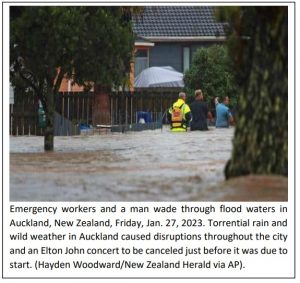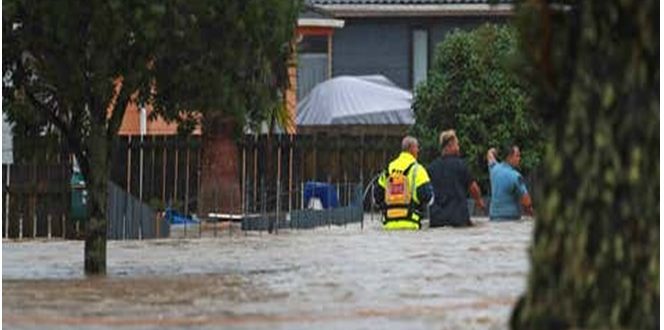Unprecedented Rains and Massive Floods Inundate Auckland
 Record rainfall from 27th Jan 2023, Friday morning through overnight to Saturday morning continued to batter Auckland, causing massive flooding, landslides, flash floods, knocking out roads and disrupting air traffic.
Record rainfall from 27th Jan 2023, Friday morning through overnight to Saturday morning continued to batter Auckland, causing massive flooding, landslides, flash floods, knocking out roads and disrupting air traffic.
Auckland, New Zealand’s largest city of 1.6 million people, remained under a state of emergency on Sunday. The nation’s weather forecaster, MetService, warned of more severe weather on Sunday and Monday for the north island. Intense rainfall could also cause surface and flash flooding, it said.
The country’s national meteorological service, MetService, issued Red Heavy Rain Warning for the Auckland area overnight and recorded 249mm of rain in 24 hours until 1 AM on Saturday
 Auckland is said to have received 75% of its usual summer rainfall in just 15 hours.
Auckland is said to have received 75% of its usual summer rainfall in just 15 hours.
Climate change is causing episodes of heavy rainfall to become more common and more intense in New Zealand, though the impact varies by region. Climate change minister James Shaw noted the link to climate change on Saturday when he tweeted his support for those affected by flooding.
https://weather.com/en-IN/india/news/news/2023-01-28-new-zealand-record-rainfall-massive-floods-inundate-auckland
https://www.bbc.com/news/world-asia-64440319

We’ve built our cities to be vulnerable to – and exacerbate – major weather events such as the one we saw in Auckland on Friday. While almost no city in the world could fully escape the effects of four months’ worth of rain in 24 hours, there are many things that could have been done to avoid some of the worst impacts.
Buildings, streets and car parks are all impermeable surfaces. When it rains, the water rushes off these surfaces and into gutters. From the gutters, the water drains into a stormwater catch basin, through the stormwater network, and into streams and the sea.
Herein lies the problem. The more we build, the more stormwater we need to drain. Every new building or road replaces the planet’s natural stormwater system: plants and soil, and channels for runoff.
The network of pipes can only hold so much water before it is fully inundated and begins to flood. While every block typically has a catch basin or two, they can easily clog with leaves and other debris even before a storm hits. Add an abnormal amount of rainfall, and neighbourhood flooding is nearly guaranteed.
THE ‘SPONGE CITY’:
There is a better way to design our built environment. In the early 2000s, Chinese architect Kongjian Yu created the concept of the “sponge city”. It’s a relatively simple idea, but a big departure from the way we typically build infrastructure.
The concept incorporates green roofs, rain gardens and permeable pavements to absorb and filter water. Better catch systems hold rainwater where possible and reuse it. More green space and trees are also incorporated into street and neighborhood designs.
Within the sponge city concept is a way to mitigate flooding using “water sensitive urban design”. With this approach, we create spaces that better manage flooding through systems that mimic the natural water cycle.
This can also include floodable infrastructure and parks to take the pressure off more vulnerable parts of the city. There are already examples of these design principles in Auckland, but they are far too limited to eliminate the impact of major storms.
The sponge city concept, and ideas about letting nature handle stormwater, don’t have to be extravagant or expensive. They can be as simple as planting more trees and greenery, using less pavement for driveways or more porous cement for car parks.
In a way, we should do less building and let nature do what it was meant to do.
The stark reality is the flooding we experienced this week, and arguably the storm itself, are of our own making. We’ve built a supercity covered in impervious surfaces, expanded the built environment across sensitive (and flood-prone) areas, and created massive greenhouse gas emissions destabilising the climate.
Climate change will make future storms more intense and more frequent. Do we cross our fingers and hope the rain goes away? Do we invest billions in bigger pipes that will inevitably fail to control flooding and still pollute sensitive waters? Or do we get smarter and more proactive about designing our cities?
If we don’t want to repeat the week’s events, there’s only one real option.
https://theconversation.com/auckland-floods-even-stormwater-reform-wont-be-enough-we-need-a-sponge-city-to-avoid-future-disasters-198736

